I went back to catch the stuff I missed at the Operation RAW opening, and I’m glad I did. Roberta put up a post with some images of stuff she loved, and I want to add (a lot) to it. It seems like such a survey of the Philadelphia art scene and such a bold show to do that I wanted to get something up this last weekend to remind you it’s worth the visit. Here’s my list of things that caught my attention one way or another, mostly in no particular order.
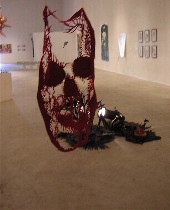 The skull, swampy weeds, shadows on the wall and message about love, not war, from a witchy little critter from Paul Swenbeck and Joy Feasley hit the target of anti-war while offering a mental and a visual trip. Since it covered a lot of space between its main elements, it’s hard to give a full photo. So here’s one detail shot.
The skull, swampy weeds, shadows on the wall and message about love, not war, from a witchy little critter from Paul Swenbeck and Joy Feasley hit the target of anti-war while offering a mental and a visual trip. Since it covered a lot of space between its main elements, it’s hard to give a full photo. So here’s one detail shot.
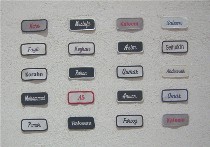 Mark Shetabi’s grid of foreign names rescued from thrift-shop gas-station uniforms is a reminder of global immigration patterns and their effect on local economies. It’s also a reminder, about the oil industry and religious migration patterns. So simple, but so complex.
Mark Shetabi’s grid of foreign names rescued from thrift-shop gas-station uniforms is a reminder of global immigration patterns and their effect on local economies. It’s also a reminder, about the oil industry and religious migration patterns. So simple, but so complex.
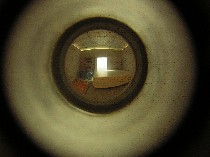 Shetabi also offered a signature peephole piece, the safe bedroom complete with the oriental rug in a bunker under a ghostly gas station. The thoughts that this is where we seem to be heading are simply unbearable.
Shetabi also offered a signature peephole piece, the safe bedroom complete with the oriental rug in a bunker under a ghostly gas station. The thoughts that this is where we seem to be heading are simply unbearable.
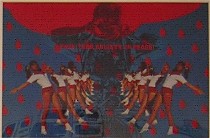 Some mordant prints from Sam Belkowitz caught my eye for their stylishness, beauty and content. “This Year Believe in Peace,” (left) with its lineup of cheerleaders, was one of the two that really knocked me out. The other, “Our Korea,” shows a couple of Asian-looking women sitting on a lawn in front of a suburban McMansion.
Some mordant prints from Sam Belkowitz caught my eye for their stylishness, beauty and content. “This Year Believe in Peace,” (left) with its lineup of cheerleaders, was one of the two that really knocked me out. The other, “Our Korea,” shows a couple of Asian-looking women sitting on a lawn in front of a suburban McMansion.
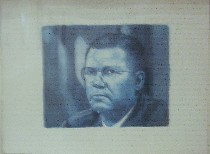 A series of five tiny, exquisite monochrome watercolors of the architects of the Vietnam War–Dean Rusk, Robert MacNamara, McGeorge Bundy, Walter Rostow and William Bundy–stunned for their technical accomplishment as well as a reminder that these, too, were once young idealists hoisted by their own petard. The artist is Mary Henderson.
A series of five tiny, exquisite monochrome watercolors of the architects of the Vietnam War–Dean Rusk, Robert MacNamara, McGeorge Bundy, Walter Rostow and William Bundy–stunned for their technical accomplishment as well as a reminder that these, too, were once young idealists hoisted by their own petard. The artist is Mary Henderson.
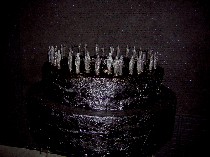 I’m putting up Gabriel Martinez oily black “Novena to St. Barbara,” even though Roberta also mentioned it, just because I got the shot (oh, I cheated) of the murky circle of warrior saints around a black pool lit with the suggestion of an oil lamp. Before I knew it was St. Barbara, I thought the figures were soldiers, saints, sheiks and other royalty. It works both ways.
I’m putting up Gabriel Martinez oily black “Novena to St. Barbara,” even though Roberta also mentioned it, just because I got the shot (oh, I cheated) of the murky circle of warrior saints around a black pool lit with the suggestion of an oil lamp. Before I knew it was St. Barbara, I thought the figures were soldiers, saints, sheiks and other royalty. It works both ways.
And while I’m in Roberta’s list, Mark Campbell’s “What my Mother Knew” was such a moving favorite with a gorgeous photograph of his family home, I just had to mention it too. Also, Nicholas Kripal’s “Specter (after UT)” metal leaf wall drawing of the most famous Vietnam photo of all, the young girl stripped bare by napalm, is pretty amazing, the sense of dissolving materials–the clothes, the metal leaf–and dissolving lives was a knockout. In a similar vein, I thought I’d mention Don Fox’s “Silent Witness,” a series of six frames of a woman in a conical hat looking disturbed and startled and horrified (or maybe I’m reading a lot in).
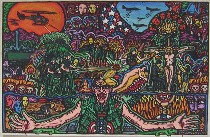 Also Houston Ripley’s “Sacrificial ‘Nam” took over an entire wall with its buzzsaw outsider-outlined, kaleidoscopic patterns that turned into explosive images of war and death.
Also Houston Ripley’s “Sacrificial ‘Nam” took over an entire wall with its buzzsaw outsider-outlined, kaleidoscopic patterns that turned into explosive images of war and death.
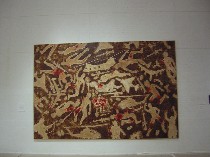 It was nicely paired with Ira Upin’s “Shared Sacrifice,” on the opposite wall.
It was nicely paired with Ira Upin’s “Shared Sacrifice,” on the opposite wall.
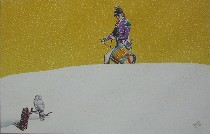 Another soldier from Matt Fisher, “March,” offers a poetic look at a soldier noticing an owl and feeling the weather and just being a human being in his gussied up uniform from times past. Fisher has a sweet story-book innocence in his work plus a sense of beauty and time standing still for a moment. It felt like a break from the fury of the show.
Another soldier from Matt Fisher, “March,” offers a poetic look at a soldier noticing an owl and feeling the weather and just being a human being in his gussied up uniform from times past. Fisher has a sweet story-book innocence in his work plus a sense of beauty and time standing still for a moment. It felt like a break from the fury of the show.
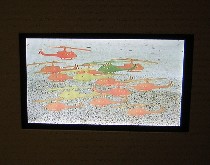 A little looping DVD from Sarah Zwirling panning up into the clear blue sky and then slowly panning down to one helicopter, then a bevy of them, raises questions of what foolishness we are bringing into such a beautiful world. I think the helicopters are paper cutouts.
A little looping DVD from Sarah Zwirling panning up into the clear blue sky and then slowly panning down to one helicopter, then a bevy of them, raises questions of what foolishness we are bringing into such a beautiful world. I think the helicopters are paper cutouts.
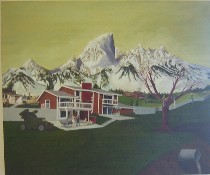 Continuing his series on war in the suburbs, Andrew Prayzner continues to catch my attention. Although this one isn’t quite as much a surprise, having seen the others, I still went for it. The pristine mountains, the tank-like vehicle in the driveway of the suburban home are a reminder of what we are doing to others in their patch of paradise.
Continuing his series on war in the suburbs, Andrew Prayzner continues to catch my attention. Although this one isn’t quite as much a surprise, having seen the others, I still went for it. The pristine mountains, the tank-like vehicle in the driveway of the suburban home are a reminder of what we are doing to others in their patch of paradise.
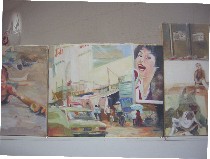 Jane Irish’s series of paintings that started this whole show include landscapes along the route of the anti-Vietnam War march Operation RAW, the inspiration for this show. Besides her recent personal pilgrimage to sites along the route, she also painted some images from the war, putting scenes like this Vietnamese busy street next to scenes of horror and carnage. The other one of these that was a beauty amidst the carnage was a breathtakingly intimate shot of a soldier and a woman making love in an exotic setting. Like Prayzner, like Shetabi, these juxtapose the everyday peaceful world with mayhem.
Jane Irish’s series of paintings that started this whole show include landscapes along the route of the anti-Vietnam War march Operation RAW, the inspiration for this show. Besides her recent personal pilgrimage to sites along the route, she also painted some images from the war, putting scenes like this Vietnamese busy street next to scenes of horror and carnage. The other one of these that was a beauty amidst the carnage was a breathtakingly intimate shot of a soldier and a woman making love in an exotic setting. Like Prayzner, like Shetabi, these juxtapose the everyday peaceful world with mayhem.
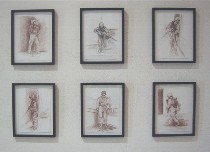 Susan Hagen’s drawings for the series of soldier carvings she is now showing at Schmidt/Dean are beauties, but it’s the carvings that are the must-see.
Susan Hagen’s drawings for the series of soldier carvings she is now showing at Schmidt/Dean are beauties, but it’s the carvings that are the must-see.
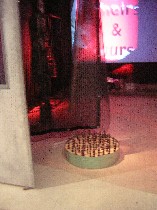 Carolyn Healy and John Phillips’ installation was especially notable for the video component of exploding word pairs–lie and deny, cradle and crucible, profit and loss, Mekong and Eurphrates, drill and kill, rich and poor, etc.
Carolyn Healy and John Phillips’ installation was especially notable for the video component of exploding word pairs–lie and deny, cradle and crucible, profit and loss, Mekong and Eurphrates, drill and kill, rich and poor, etc.
The installation included drill bits in sand and war camouflage sorts of things.
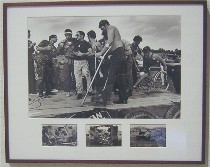 Last, I want to make sure I mention the Tony Velez photojournalism from Operation RAW, “Vietnam Memories: at War & Peace.” The triplet photos at the bottom are documentary photos of the war itself from the Vietnam Veterans Against the War. But the big ones, from Operation RAW, serve as reminders of what we lose, who we lose. This one “Assembling the Wounded,” is my favorite (silver print).
Last, I want to make sure I mention the Tony Velez photojournalism from Operation RAW, “Vietnam Memories: at War & Peace.” The triplet photos at the bottom are documentary photos of the war itself from the Vietnam Veterans Against the War. But the big ones, from Operation RAW, serve as reminders of what we lose, who we lose. This one “Assembling the Wounded,” is my favorite (silver print).









